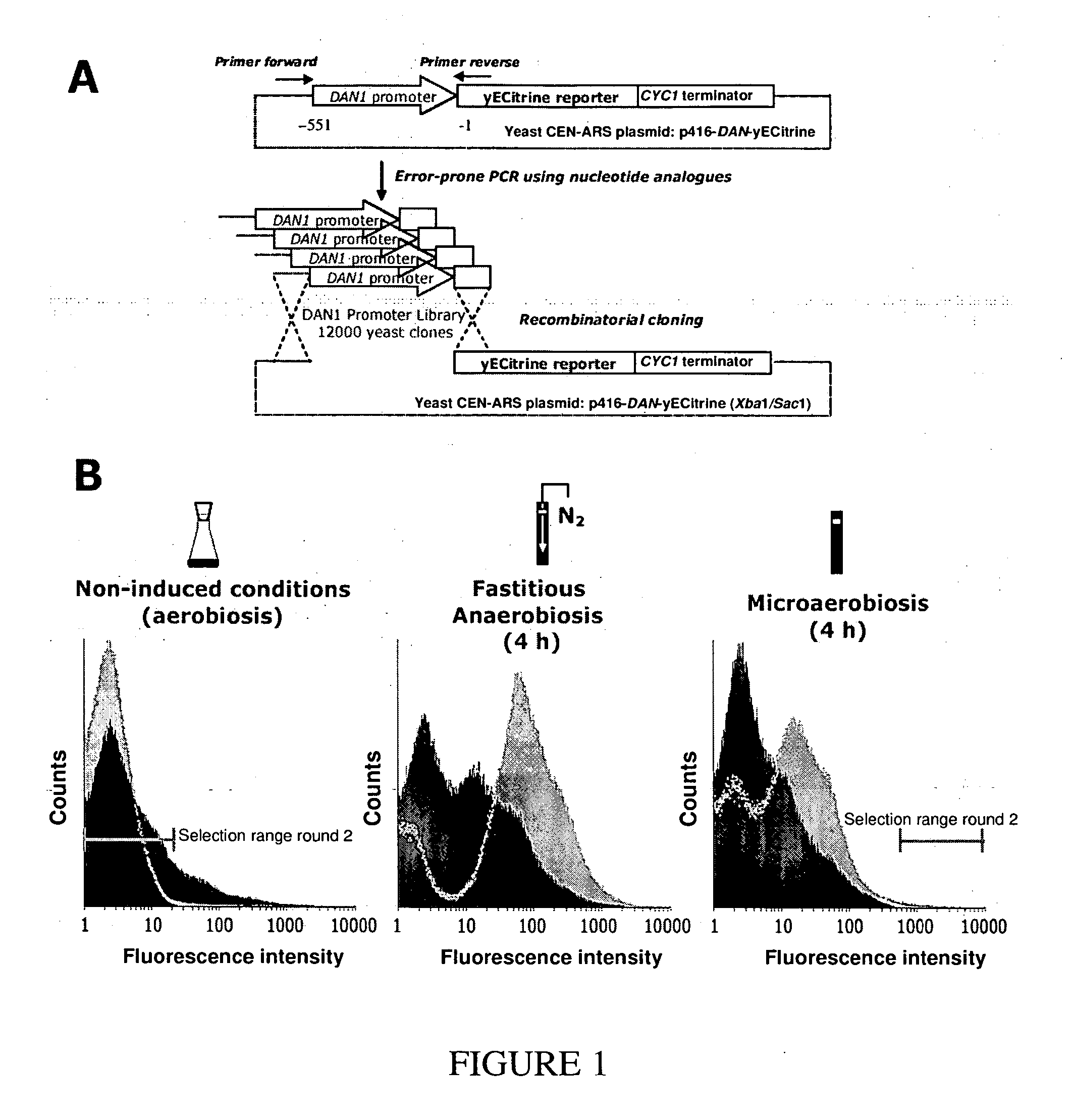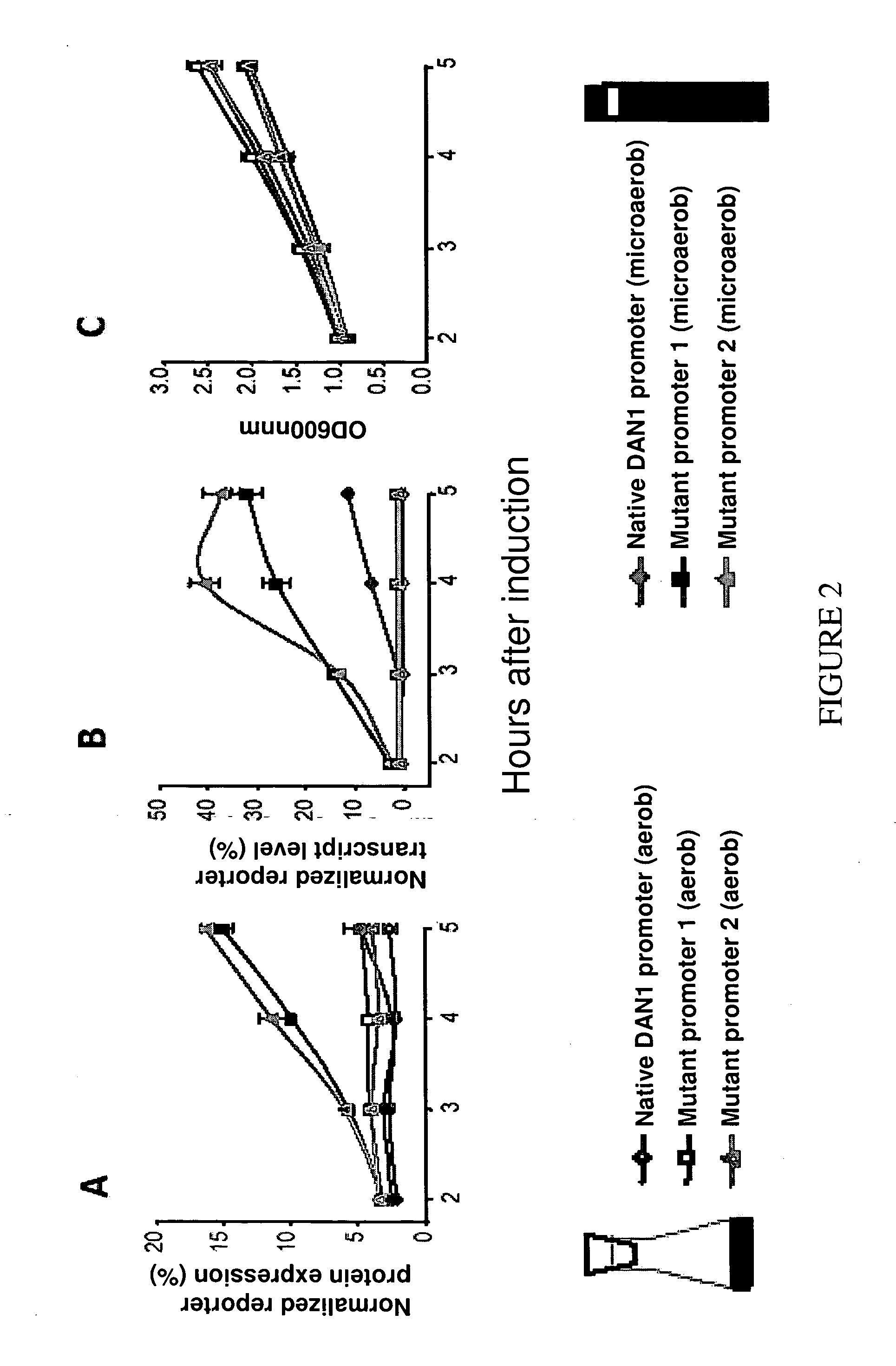Promoter engineering and genetic control
- Summary
- Abstract
- Description
- Claims
- Application Information
AI Technical Summary
Benefits of technology
Problems solved by technology
Method used
Image
Examples
example 1
[0202] Error-prone PCR technology (Zaccolo & Gherardi J Mol Biol 285, 775-783 (1999)) was used to mutate the 551 bp region of the DAN1 promoter immediately upstream of the promoter start (FIG. 1A). After PCR, the mean mutation rate was estimated to be 11.2 mutations per every 551 nt. The library of mutant promoters was cloned upstream of a yECitrine fluorescent reporter protein optimized for expression in S. cerevisiae (Sheff & Thorn Yeast 21, 661-670 (2004)). Approximately 12,000 transformants of the yeast strain BY4741 were obtained using the method of recombinational cloning.
example 2
Fluorescent Reporter Protein Production In DAN1 And Mutant Libraries
[0203] Fluorescence histograms of the mutant library and the control strain (unmutated DAN1 promoter) grown under varying conditions of oxygen availability are shown in FIG. 1B. Shake flasks were used to provide aerobic conditions and fastidious anaerobiosis was obtained by bubbling the culture with pure nitrogen. To obtain microaerobiosis, the culture was grown in closed, air-tight vials. Because residual dissolved oxygen is consumed during cell growth, these conditions sharply lower, but do not completely deplete, oxygen availability during the course of the cell growth. Full induction of the unmutated DAN1 promoter was only obtained under fastidious anaerobiosis.
[0204] The fluorescence histogram of the mutant library under fastidious anaerobiosis (FIG. 1B) showed that approximately 20% of the library was induced to some extent, which is indicative of the wide-spread conservation of essential DAN1 features among...
example 3
Fluorescence Associated Cell Sorting
[0205] The promoter mutant library was subjected to multiple rounds of fluorescence associated cell sorting (FACS). For the first round, which was designed to remove all promoter mutants no longer repressed by oxygen, cells were pre-grown under aerobic conditions and sorted by FACS using the cutoff shown in FIG. 1B to eliminate mutants showing high fluorescence (i.e. promoter activation under aerobic conditions). The sub-library isolated in this way contained 87% of the clones in the original library. For the second round of FACS, cells of the sub-library were subjected to microaerobic conditions for 4 hours. Despite the fact that the vast majority of library clones were less fluorescent under fastidious anaerobiosis than the wild-type DAN1 promoter, we screened our sub-library for mutants at the extreme high end of the fluorescence distribution, as shown in FIG. 1B. This stringent cutoff resulted in the elimination of 99.98% of the library membe...
PUM
| Property | Measurement | Unit |
|---|---|---|
| Time | aaaaa | aaaaa |
| Time | aaaaa | aaaaa |
| Mass | aaaaa | aaaaa |
Abstract
Description
Claims
Application Information
 Login to View More
Login to View More - R&D
- Intellectual Property
- Life Sciences
- Materials
- Tech Scout
- Unparalleled Data Quality
- Higher Quality Content
- 60% Fewer Hallucinations
Browse by: Latest US Patents, China's latest patents, Technical Efficacy Thesaurus, Application Domain, Technology Topic, Popular Technical Reports.
© 2025 PatSnap. All rights reserved.Legal|Privacy policy|Modern Slavery Act Transparency Statement|Sitemap|About US| Contact US: help@patsnap.com



